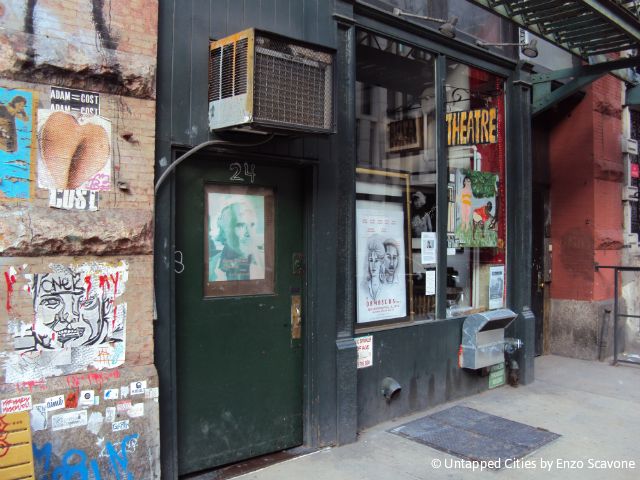Last Chance to Catch NYC's Holiday Notalgia Train
We met the voices of the NYC subway on our nostalgia ride this weekend!


Over the course of the 21st century, NYC’s DIY music scene has transformed into one of the city’s most thriving artistic institutions. Although it may not share the visibility of such lofty institutions as PS1, many of the city’s grassroots performance spaces have gone on to influence music and contemporary culture at large. Yet many people may not realize that NYC’s DIY tradition was born out of an unlikely crossing of artistic paths.
It all began at 24 Bond Street, a building that was once owned by the painter Virginia Admiral, who also happened to be the mother of Robert DeNiro. It was originally designated as an artist residency and to this day, the building remains relatively untouched by NoHo’s rampant gentrification. In fact, it remains very close to how it would have originally looked after its construction in 1893.
The only drastic difference now are the series of gold acrobats that wrap around the building’s second floor windows. These statues were built from 2006 to 2010 by artist Bruce Williams, though the work entitled “Dreams of Hyperion” is not related to Gene Frankel Theater, an influential theater space that’s still in operation as a workshop for young actors on the off-off-Broadway scene. But what many people may not know is that what began as jazz musician Sam Rivers‘ Bond Street loft in 1969 would soon become an equally influential haven for like-minded musicians.
Avant-garde jazz still faced a great deal of adversity during the 1970s and many musicians who wished to push the conventions of their craft could not find the same work or acceptance in NYC as other, more traditional players. Rivers, who was in the midst of pushing jazz towards its outer limits, was frustrated with this situation. As a result, Rivers transformed his loft into Studio Rivbea, arguably one of NYC’s first DIY performance spaces.
Named in part after his wife, Beatrice, Studio Rivbea was the first in a series of small converted performance spaces that would comprise what’s now considered NYC’s loft-jazz scene. John Coltrane’s drummer Rashied Ali had also converted his apartment into what was referred to as Ali’s Alley.
According to Will Hermes, who wrote an amazing account of NYC’s diverse music scene during the 1970s called “Love Goes to Buildings on Fire,” Studio Rivbea was “ground zero for the loft scene.” By bypassing the conventional means of support and promotion, Studio Rivbea set a new standard of creative freedom and acceptance that can still be felt in today’s underground musical climate.
Donations were given at the door to pay rent as well as to help support the night’s musicians. Impromptu performances were the norm and often proceeded well into the early morning hours. This led to many unlikely experiments and one-off collaborations that could have never occurred in any other environment. Everybody from Anthony Braxton to former Coltrane collaborator Marion Brown could be found jamming together on any given day of the week if you were lucky enough to catch it. Thankfully, some of these spontaneous jam sessions could be heard on Wildflowers, a five LP compilation recorded at Studio Rivbea’s 1976 festival. According to Will Hermes, Wildflowers is “the best document of the loft scene on record.”
Although both Studio Rivbea and Sam Rivers are now gone, the survival of the 24 Bond Street that we see today can mostly be attributed to the efforts of the Gene Frankel Theater. As a result of the theater’s artistic significance, the original building was saved from becoming a condo after it was recognized by the NYC Landmarks Preservation Commission in 2008. It is also not surprising to note that the man behind the theater, actor Gene Frankel, was also behind the Mercer Arts Center in Greenwich Village, a venue that set the stage for NYC’s DIY scene in many ways. The New York Dolls and the Modern Lovers are two of the many unconventional rock groups that were welcomed at the Mercer Arts Center during its operation.
But perhaps the most recognizable name connected with the building is the late Robert Mapplethorpe. The New York photographer, responsible for such iconic images as the cover of “Horses” by Patti Smith, had actually kept his studio at 24 Bond Street all the way up until his death in the 1980s. According to Will Hermes, he would even come down to check out the music. But even though Mapplethorpe’s name has been rightfully etched into the annals of history, perhaps it is Studio Rivbea that has had the most lasting impact on the city.
Studio Rivbea lives on in today’s increasingly influential DIY scene and has set the stage for the kind of creative autonomy that many of today’s young musicians take for granted. Even though CBGBs is often lauded as NYC’s original hotbed of creativity, Brooklyn’s thriving loft scene can attest to how Rivers’ even more unconventional approach to providing us with cutting edge artists has helped change the way the city listens to music.
Did this interest you? Find out more by contacting the author @douglascapraro.
Subscribe to our newsletter